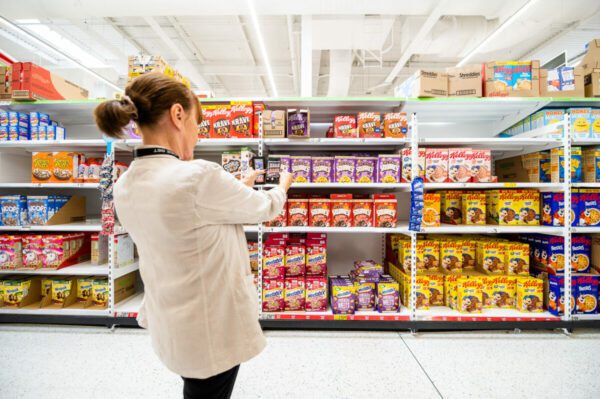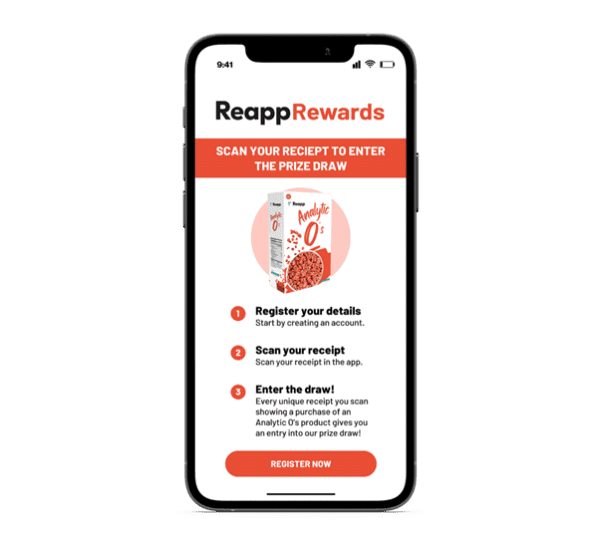Here at Reapp, we believe that your customers should be at the heart of everything you do. That’s why if you’re a business seeking long-term success, keeping your customers happy and engaged with exciting rewards is key, making measuring brand loyalty a major part of your success.

Capital One Research recently reported that ‘56% of consumers surveyed claim more loyalty to businesses that ‘get’ them’. This shows us the importance of understanding consumer needs and ensuring that their expectations are met. Happy customers are repeat customers – building brand loyalty will ensure that your business continues to strive in the competitive market. Loyal customers will not only return to your business but also advocate for your brand, recommending you to their peers and contributing significantly to your revenue over time.
But how do you effectively measure something as abstract as loyalty?
In this blog post, we’ll explore four powerful strategies for measuring brand loyalty, so that you can assess the health of your customer relationships and build a more robust, long-lasting business.
If you’d like to see how we can help you create the perfect rewards scheme for your brand, please get in touch with our team today.
Understanding Brand Loyalty: Why Is It So Important?
If you’re searching for the definition of brand loyalty, you’re in the right place!
Brand loyalty is a key indicator of your businesses’ relationship with its customers, reflecting the level of trust, transparency and emotional connection customers feel towards your brand. When customers repeatedly choose your business over your competitors, you will have successfully cultivated a good level of brand loyalty.
Why is this so important? Because these days, consumers have so many options available to them – thanks to the effects of the cost-of-living crisis, consumers’ shopping habits have shifted. Marketing Week recently reported that 52.9% of consumers are now willing to switch brands if they can save money. If they know they can get the same product for a lower price in another store, why would they stay loyal?
That’s why it’s so important for businesses to ensure that they are providing their customers with the best value, whilst also offering them lucrative personalised offers to keep them coming back for more, such as impactful loyalty programs. According to research by Bain & Company, increasing customer retention by just 5% can boost profits by as much as 95%, suggesting that investing in customer loyalty will only improve your business. Loyal customers also create a buffer during tough times, such as economic downturns or when competitors attempt to lure customers away with aggressive pricing.
Understanding and measuring brand loyalty allows businesses to optimise customer satisfaction, improve their marketing strategies, and foster long-term success.
Now, let’s dive into the most effective ways to measure this invaluable aspect of your business…
The Master Plan: Our Top Strategies for Measuring Brand Loyalty
There are several modern field marketing strategies you can adopt to gauge your brand’s loyalty. In this next section, we’ll break down four major examples of brand loyalty strategies that will help you understand and quantify customer loyalty.
Let’s discover the major benefits of brand loyalty!
Foster Customer Loyalty by Analysing Your Repeat Purchase Rate
One of the most straightforward ways to measure brand loyalty is by tracking the repeat purchase rate (RPR). This metric tells you the percentage of customers who make multiple purchases or engage with a business repeatedly over a specific period.
To calculate your RPR, simply divide the number of customers who made more than one purchase by your total number of customers within that time frame, and multiply by 100 to get a percentage. For instance, if you had 500 total customers and 150 made a second purchase, your repeat purchase rate would be 30%.
These insights provide you with a clear metric which can be used as a clear indication of your business’s performance and health when it comes to maintaining relationships with your existing customers. A higher RPR suggests strong brand loyalty, whereas a lower rate may suggest that customers are either dissatisfied or tempted by competitor offerings after their initial purchase.
How Can You Improve Your RPR?
A great place to start when improving your repeat purchase rate is to understand who your consumers are and what they want from you. It may be helpful to carry out a customer survey which will provide you with qualitative responses, helping you to shape and transform your retail operations.
Adding to this is the fact that most customers nowadays appreciate more of a personalised approach. Research from McKinsey and Company showed that 71% of consumers now expect companies to deliver personalised interactions. This shows that the more tailored your recommendations, the more effective they become. By identifying which products a customer is most interested in, you can streamline their shopping experience, making it effortless for them to add items to their cart without needing to search extensively. A seamless shopping journey increases the chance that your customers will return for future purchases.
Lastly, introducing a loyalty card scheme is a great way to encourage customer loyalty. By providing customers with exclusive incentives, you’re communicating to them that you’re thankful for their custom and that you care about their overall experience. When customers feel valued, they’re more likely to return. A great example of a loyalty card scheme that also utilises the art of personalisation is Tesco’s Clubcard Challenges. This scheme provides shoppers with the opportunity to earn extra points by hitting certain personalised targets on their spending.
Calculate Your Net Promoter Score (NPS)
Another effective way to measure brand loyalty is through your Net Promoter Score (NPS). This widely used metric measures how likely customers are to recommend your brand to others. NPS surveys ask a simple question: ‘On a scale of 0 to 10, how likely are you to recommend us to a friend or colleague?’ Based on their responses, customers are categorised into three groups:
- Promoters (9-10): These are your loyal, enthusiastic customers who are likely to recommend your business to others.
- Passives (7-8): These customers are satisfied but not enthusiastic, and may switch to a competitor if given the opportunity.
- Detractors (0-6): Detractors are unhappy customers who may harm your brand’s reputation through negative word-of-mouth.
To calculate your NPS, subtract the percentage of detractors from the percentage of promoters. The result can range from -100 (all detractors) to 100 (all promoters). A positive score indicates that more people are likely to recommend your brand than criticise it, which is a strong signal of brand loyalty.
How to improve your NPS: To boost your score, focus on addressing the main concerns of detractors and turning passives into promoters. Transparency is key and detractors will appreciate regular updates that show that you care about enforcing change. Additionally, it may also be helpful to encourage regular customer feedback by offering incentives. Lastly, you should always ensure that communication is personalised to enhance the customer experience, which will also improve the quality of your data.
Nurture Your Customers and Boost Your Customer Retention Rate
Your customer retention rate (CRR) is another powerful indicator of brand loyalty. This metric tracks the percentage of customers who continue to do business with you over a given period. A high retention rate signals strong loyalty, whereas a low retention rate suggests that your customers are seeking out other alternatives.
To calculate your CRR, use the following formula which involves the customers you have at the start (S), at the end (E), and the customers acquired during the period you’re measuring (N).
It looks like this: CRR = ((E-N)/S) x 100.
For example, if you started the quarter with 130 customers, gained 23, lost 9 new customers, and ended the quarter with 44 customers, your retention rate would be:
144 – 23 / 130 x 100 = 93% retention rate.
A 93% retention rate is a solid indicator that your customers are happy with your brand and are loyal enough to stay with you.
How to improve your CRR: Implement strategies like regular follow-ups, personalised offers, and loyalty rewards to maintain and grow relationships with your existing customers. The longer customers stick with your brand, the more likely they are to become brand advocates.

Embrace Our State-of-the-Art Rewards Solution
Supermarket loyalty schemes are a great way to enhance brand loyalty. Incorporating a rewards scheme solution can significantly impact customer retention and satisfaction. Offering customers incentives such as points, discounts, or exclusive access for repeated purchases or engagement encourages them to keep coming back. The more frequently customers engage with your rewards program, the higher their loyalty to your brand.
Have you tried Reapp Loyalty? We make creating loyalty schemes, rewards programs and competitions easier than ever before.
Loyalty is the complete solution when it comes to connecting customers with your brand, enabling you to collect valuable customer data insights that will help you to improve your future marketing efforts. Loyalty can collect photographs of receipts via our powerful image recognition tech and use these to understand purchase locations, common basket items, popular basket sizes, and the shopping habits of your customers. You can also retain customer information (if users accept the conditions), which can then be reused for future marketing campaigns. This data can be segmented by preference, location, age, gender and more!
Why not try it for yourself and book a demo?
How to enhance your rewards program: Ensure your retail rewards system is simple, personalised, and easy to use. Provide clear value for participation and offer exclusive rewards that make customers feel appreciated. Customising the program to your individual customer preferences will further increase engagement and brand loyalty.
Measure Your Success with Confidence
Brand loyalty isn’t something that should be ignored. Measuring your brand loyalty will give you a better chance at understanding your customers’ behaviour, satisfaction, and emotional connection with their brand. By analysing your repeat purchase rate, tracking your NPS, boosting your customer retention rate, and embracing a well-designed consumer rewards program, you’ll gain a comprehensive understanding of where your business stands in terms of loyalty.
These strategies will give you the confidence to refine your offerings, improve customer experiences, and ultimately foster stronger, longer-lasting relationships with your audience. When you can accurately measure brand loyalty, you’ll be better equipped to cultivate it, driving growth and ensuring the long-term success of your business.
If you’re still not sure how to measure brand loyalty and you’d like some help integrating these strategies into your business plan, we’ll be happy to help. You can also find out how we’ve helped our other clients with their reward schemes on our case studies page.
With our help, you can find out your customers’ ideal wants, needs, and passions, before putting them into play in real-time. Get in touch today to see how we can help you to improve your brand loyalty strategy!
